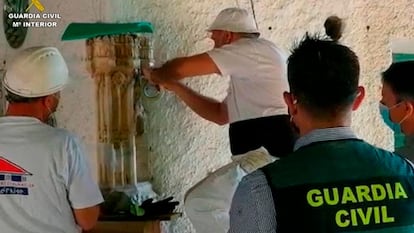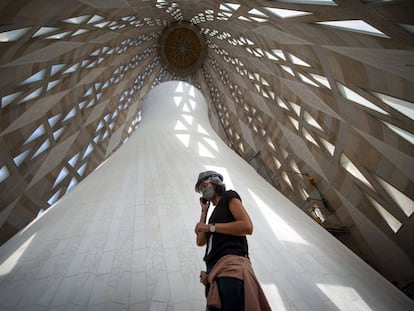A retired police officer’s infallible memory cracks a baffling case of lost treasure in Spain
After watching a TV documentary, Emiliano Fernández provided the clue that solved a 84-year-old mystery involving a priceless Gothic tomb


Emiliano Fernández, a retired police officer specialized in bomb disposal, has two gifts. One is a prodigious memory that helps him to relive episodes of his life with unusual intensity, such as remembering exactly where his parents, relatives and schoolmates sat at the table at his eighth birthday party.
His other gift concerns religious art. After years of studying religious figures, he can walk around any church in the world, listing the age and quality of the pieces on display. Fernández can tell at a glance if something is made of plaster, alabaster or if it has simply been mass produced.
At the end of February, these two talents combined to help him immediately recognize a fragment of a Gothic tomb that was stolen from the cathedral of Alcalá de Henares back in July 1936, at the start of the Spanish Civil War. The story of the missing artwork featured in a television documentary called The Guardians of Heritage broadcast on the Spanish channel La 2. From the comfort of his own couch, Fernández was able to solve an 84-year-old mystery.
“I recognize that, dammit!” he told himself as he heard that one of the four miniature alabaster towers once embedded in the Gothic tomb of Archbishop Carrillo Acuña, and dating back to the 15th century, was still missing. Immediately, Fernández was transported back to 1975, when he was a 20-year-old doing his military service and frequently visiting a friend’s estate in Chinchón, in the Madrid region.

In one of the cowsheds on that estate there was an artwork made of alabaster embedded into the wall. Nobody in his friend’s family ever paid much attention to it, but Fernández felt drawn to it, surmising that it was a fragment of an altarpiece. At the very least he knew it to be from the Gothic period because of the inscription. Fernández recalls that he liked to feel the coldness of the stone, and did so on dozens of occasions as he realized that it was a unique and valuable piece of religious art.
Forty-five years later, as he watched the documentary, his memory of that artwork was still intact. After making some inquiries, he discovered that it remained embedded in the wall of the cowshed on the estate, which is now a rehabilitation center run by the Montemadrid Foundation for drug addicts, ex-convicts and the homeless. They milk cows, make bread and grow vegetables on the premises.
Having located the missing piece, he then called the central office of the Alcalá de Henares Diocese to alert them to its whereabouts. He didn’t expect any fanfare, but nor was he prepared for the indifference with which the information was received. He was asked to write an email, to explain who he was, and to follow other bureaucratic procedures that would test the patience of a saint. Frustrated, Fernández said: “Look, I’ll leave you my phone number. If you want to, you can call me. Thank you.”
Just a few minutes later, he received a call from Juan Miguel Prim, the episcopal vicar in charge of cultural affairs at the Alcalá de Henares Diocese. This time, there was mutual understanding: both men were aware of the importance of Fernández’s discovery.
The documentary that Fernández had seen on television was about Operation Temperance, an investigation by Spain’s Civil Guard that culminated in the recovery of two other missing reliefs from the tomb of Archbishop Carrillo: those representing Temperance and Prudence. But one piece was still unaccounted for.
The artworks disappeared in July 1936, after a fire destroyed the cathedral, leaving it wide open to looting. Several reliefs decorating the sides of the tomb disappeared, and the whereabouts of the final missing piece remained a mystery until Fernández put two and two together, realizing that this was the piece embedded in the cowshed wall that he had been drawn to in his youth.
His friend’s family had bought the estate from Armando Muñoz Calero, a physician with Francoist sympathies who was also president of the Spanish Soccer Federation in the 1950s and vice-president of the Atlético de Madrid soccer team, although it is not known how he came to have the artwork in his possession.
Fernández remembers the estate as a wonderful place surrounded by the Tajuña River, with a manor house and a mill and various antiques, although Fernández’s friends and family were more enthralled with the natural beauty of the spot, which also had orchards and meadows.
The Civil Guard officer who led Operation Temperance, Lieutenant Águila, eventually contacted Fernández, who was able to provide him with current photographs of the estate uploaded online by Garaldea, the association that runs the rehabilitation program.
The artwork has since been removed from the estate and placed in storage until it can be restored and re-integrated into the tomb, returning it to its original state 84 years after it was dismantled.
“It has really been a fantastic example of citizen collaboration,” says Águila. “Fernández has made it very easy for us.”
Fernández could have acted differently, of course: he could have bought the piece himself for a pittance and sold it on, but he chose to do the right thing.
According to the retired officer of the law, nobody from the Catholic Church, the Culture Ministry or the Madrid regional government has been in touch to congratulate him.
English version by Heather Galloway.








































